
‘In the 1970s, American universities and art schools began to include filmmaking in their curricula. Generally, the charismatic teachers they hired to conduct such courses were a generation of avant-garde filmmakers. They were mostly brilliant autodidacts (such as Stan Brakhage, Ken Jacobs, George Landow a.k.a. Owen Land, Hollis Frampton, Lawrence Jordan, and Ernie Gehr), or, if they had formal educations, they had taught themselves cinema (Robert Breer, Larry Gotheim, Paul Sharits, and Tony Conrad were examples of this).
‘From these schools there emerged the first generation of artists who had been taught how to make avant-garde films. Most of those who survived as filmmakers became teachers themselves: Saul Levine, Marjorie Keller, Bill Brand, and Louis Hock all came out of the School of the Art Institute of Chicago. They were steeped in the history and aesthetics of American avant-garde cinema; in short, they worked within an artistic tradition.
‘Coleen Fitzgibbon shared their training at the Art Institute but not their aspirations. She did not see herself as a filmmaker but as an artist who made, or used, cinema among other media. She did not aspire to produce a corpus of work like that of her teachers. She was familiar with the parameters of the avant-garde cinema that her peers had inherited, but she was not emotionally committed to it. Her ironic stance was her strength. In a few years in the early 1970s, she made a series of radical films and then put aside the medium to focus on other modes of artistic invention. Her FM/TRCS transformed the then-dominant genre of cinematic self-portraiture into something visually unique, from which the indices of selfhood had been erased. Then, in an astonishing gesture, she made the most reductive of all flicker films, Internal System, exposing the color temperatures of the projection apparatus itself and the auditory “heart murmur” of the motionpicture camera as it exposed film. Later, at a time when Michael Snow, Frampton, and Landow were exploring the power of words on the screen, she found a way to make utterly original films out of microfiche.
‘Fitzgibbon has worked on film and sound projects for Dennis Oppenheim, Gordon Matta-Clark and Les Levine. She formed the collaborative X&Y with Robin Winters in 1976 and helped form a conceptual art project called The Offices of Peter Fend, Fitzgibbon, Jenny Holzer, Peter Nadin, Richard Prince and Robin Winters in 1979 (the same year she performed at Public Arts International/Free Speech), and co-founded the New York-based Collaborative Projects, Inc. (Colab) in 1977 through 1981, along with forty plus artists. She was president of Colab during the formation of The Times Square Show.
‘Fitzgibbon and Alan W. Moore created an 11:41-minute film in 1978 (finished in 2009) of a No Wave concert to benefit Colab called X Magazine Benefit, documenting performances of DNA, James Chance and the Contortions, and Boris Policeband in NYC in the late 1970s. Shot in black and white Super 8 and edited on video, the film captures the gritty look and sound of the music scene during that era.
‘Two generations of film students passed through the schools. The second of these included young scholar-filmmakers interested in film preservation and in the exhibition of lost or forgotten filmmakers. The rediscovery of Fitzgibbon’s philosophically radical cinema of the 1970s, 30 years later, reawakened an enthusiasm for the medium in the artist herself, who then embraced the latest technologies, including the iPhone, to make new films and reshape her “forgotten work.”’ — P. Adams Sitney
___
Stills



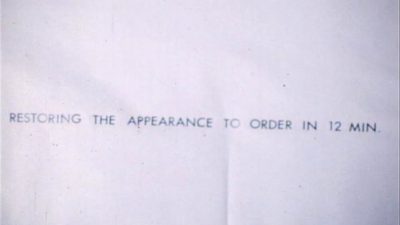
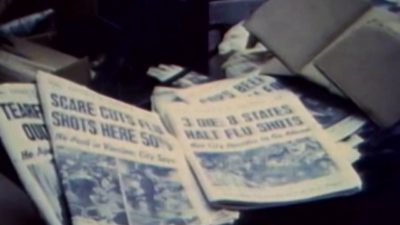
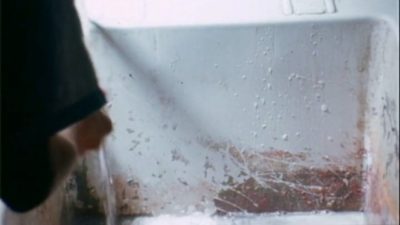
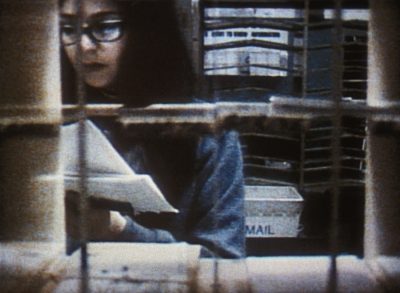
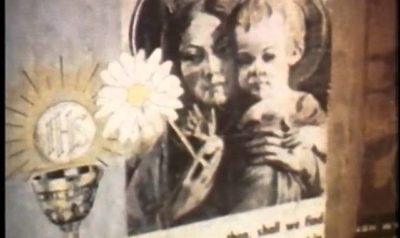
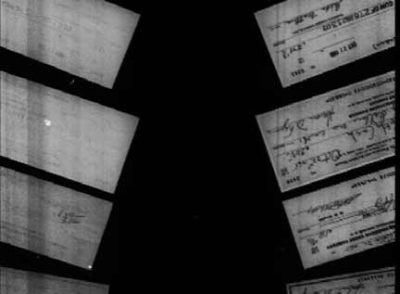


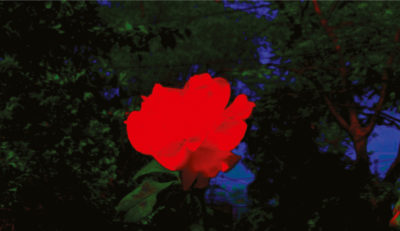

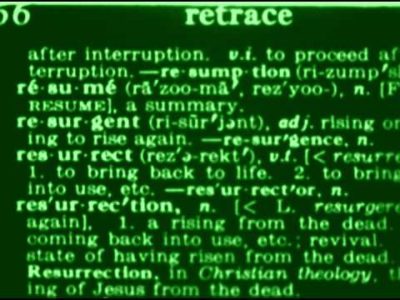

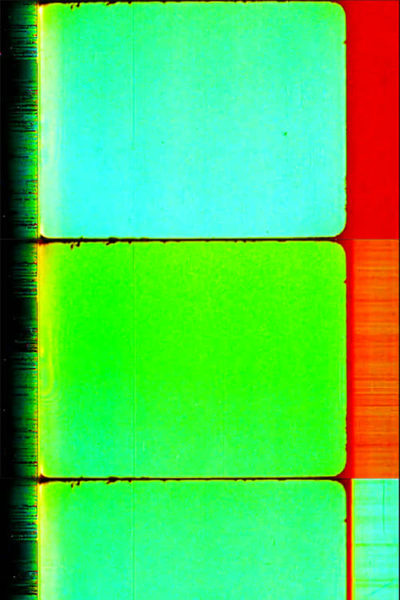
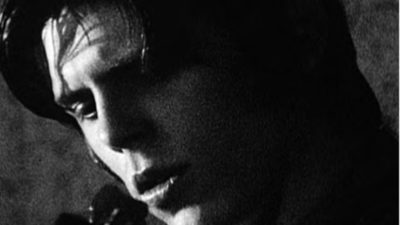





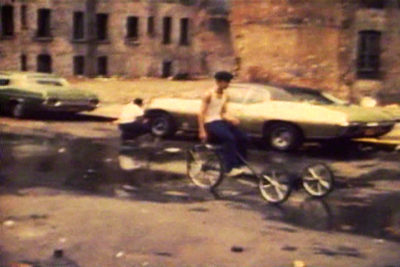



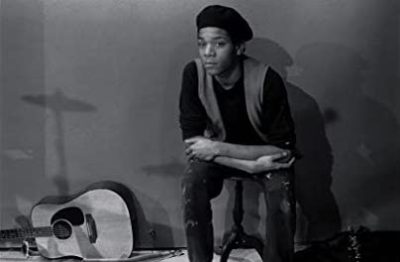
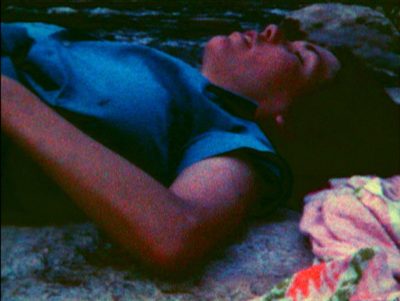





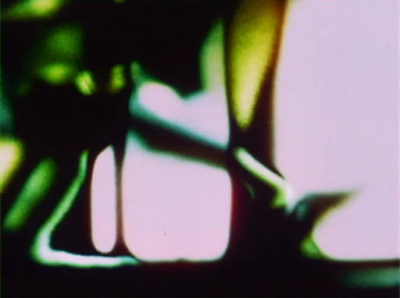


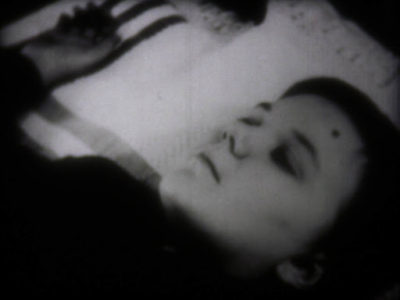
____
Further
Coleen Fitzgibbon Site
Coleen Fitzgibbon @ Light Cone
Coleen Fitzgibbon @ Twitter
CF @ instagram
CF @ The Film-makers Coop
Times Square Show Revisited
Coleen Fitzgibbon by P. Adams Sitney @ BOMB
DVD: ‘Diary Films & Micro Films’
DVD: ‘Coleen Fitzgibbon DVD compilation’
Coleen Fitzgibbon: Internal Systems
Coleen Fitzgibbon @ MUBI
A Moment of Truth (With Drinks)
Podcast: Coleen Fitzgibbon by Brainard Carey
Beth B by Coleen Fitzgibbon
Kristi Zea & Jacki Ochs by Coleen Fitzgibbon
Carolee Schneemann by Coleen Fitzgibbon
On the Paintings of David Lynch by William J. Simmons & Coleen Fitzgibbon
Ben Rivers by Coleen Fitzgibbon
____
Extras
The films of Coleen Fitzgibbon
Colab Talks at Printed Matter
Coleen Fitzgibbon Dorian Grey NOD Talk
____
Interview
from BOMB

P. Adams Sitney When did you start making 8 mm films? Was that in Boston?
Coleen Fitzgibbon No, in Chicago—before that I had a phobia about everything mechanical. Olden Camera sold me the 16 mm cartridge camera and later an 8 mm, which was cheaper to use. Sadly I didn’t make prints then because of the costs. I showed the original (reversal) films.
PAS I don’t know if I’ve seen many of these 8 mm films. I saw the film you made with Margie [Marjorie Keller] and Saul [Levine].
CF I recently found raw footage that Marjorie, Saul, his grad class, and I shot in 1976 with the Super 8 Leacock system. We never edited it, so I made a version called Make a Movie. I used to film with 8 mm on the Chicago streets pushing Tri-X film if they were night scenes, and when I got to New York, I made a series of Super 8-sound street interviews in Times Square. While I was in Chicago, we showed each other works in progress constantly.
PAS Do you mean you and Saul and Margie or a larger group?
CF Saul Levine, Marjorie Keller, Jim Curtis a.k.a. Diego Cortez, Bill Brand and his then wife JoAnn Elam, Christa Maiwald, Louis Hock, Seton Coggeshall, Ruby Rich, Gunner, Ramon White, and a few others. Summers, Diego and I projected experimental films on the outside wall of my building, and our neighbors who worked in the factory across the street brought their lawn chairs. We also went to Ruby Rich and Gunner’s, watched films and drank purple-haze punch. I first saw Kenneth Anger’s Scorpio Rising at a Ruby and Gunner party, and was so inspired, I sent Anger a letter and a box of 3-by-5-inch glass negatives of architecture. The unprotected glass arrived in shards, and he sent a cryptic response asking if my intention was to send him images or splinters of reflection.
PAS Did you ever meet?
CF Briefly at SAIC when he came as a visiting artist. I first saw Anger’s films in Brakhage’s film history class. Brakhage was the Scheherazade of the experimental film world; he showed almost 200 films (almost all by men) the two years I was there.
PAS Well, there were mostly films by men, but he would have shown Maya Deren and maybe Gunvor Nelson, although there weren’t many works by women available on distribution.
CF Why not? And yes, he did show Deren, Nelson, Leni Riefenstahl, and Marie Menken.
PAS It was this boys’ technical thing. But Brakhage was never someone who didn’t want to promote women. He was always big on Joan Mitchell as a painter, Gertrude Stein was his favorite poet, and his then-wife Jane had a big influence on his work. He was always promoting Marie Menken, for example. But it was only in the ’80s that people did research to find women like Jane Congor, whose films had never been in distribution. Some of the by-then-older filmmakers began to show up again. But largely it had been a boys’ thing to make films.
PAS Among your early films is Henry Darger’s Room from 1973?
CF Yes. Near the end of my stay in Chicago, Michael Baruch, a SAIC student of Nathan Lerner’s (Darger’s landlord), asked me to film an apartment where they had found artwork and wanted to get an opinion as to whether to save it.
PAS Oh, this is when they had just discovered Henry Darger’s stuff?
CF Exactly. I had one 100-foot roll of Super 8, so I single-framed items in Darger’s apartment. Garbage came up to your knees, but in it were huge books of writing and beautiful but bizarre cartoon watercolors of little girls. Everyone agreed it needed to be preserved. In the mid-’90s I started a short documentary on Henry Darger with Michael Thompson and interviewed several people related to the Darger mystery. Michael and I had a falling out so we gave footage and research to Mark Stokes, who made Revolutions of the Night, the film about Darger, in 2011.
PAS And you made a film about getting dressed.
CF In Chicago I tried hallucinogens and sort of freaked out. Later Jack Smith told me I had agoraphobia. I couldn’t leave the house; it was like Exterminating Angel except I was alone. So I filmed daily activities that I was obsessing over, edited them into a parabolic structure, and titled it Frame of Mind.
PAS So you had this footage of yourself getting dressed?
CF Yes. I decided to obscure the images to parallel my physiological state—I was hearing and seeing weird peripheral sounds and movements probably due to psychedelic flashbacks, but who knew then? I took the original 8 mm Frame of Mind and optically printed it to 16 mm, using high and low contrast mats to blow out the images. It was retitled FM/TRCS.
PAS That was the first film of yours that I saw. I was on the jury at the Knokke–Le Zoute film festival in Belgium in 1975 and your film was so unusual and so distinctive that it was one of the few films that the jury quickly agreed to give a prize to. The head of the festival and the museum, Jacques Ledoux, really believed in the word experimental. And for them this film was almost a kind of laboratory experiment.
I recently saw your transfer of I. S. Migration (1975/2010). I found it much more challenging now than 30 years ago—I think you were projecting original footage back in the ’70s.
CF Yes, I projected originals then. The new version is a digital transfer of Internal System, supersaturated and showing the optical track and digital-transfer raster in the frame, continuing the idea that all processes are visible. I had only shown Internal System once since the initial 1975 Knokke screening when most of the audience left the theater.
PAS But that wasn’t unusual at a festival. There was an enormous social scene outside and a lot of draw outside the auditorium.
CF Yep, it was a casino with huge chandeliers, Pierre Clémenti with entourage, Otto Muehl and AA-Kommune (Aktionsanalytische Organisation), gamblers, free alcohol and food… .
PAS Shortly after that you got the job working with microfilms, didn’t you?
CF From 1974 to ’79 I worked part-time for Rick Van Auken’s Information Technology Center microfilming public documents (warrants, bankruptcies, debts, etc.), learning computer language and storage and retrieval machines. Rick had been a ’60s Apollo space-program analyst.
PAS But your films there weren’t made with a computer?
CF No, they were on microfilm. My first job experience was filming documents of warrants in the New York Supreme Court basement on a 16 mm microfilm camera for the court system.
PAS So you made your own copy of the stuff?
CF After-hours, I made my own text films on the microfilm camera. I filmed magazines, newspapers, dictionaries, documents—which became the films Time Magazine, Der Spiegel, Daily News, Dictionary, and Document. Showing microfilm is very subliminal because the microfilm camera frame films the equivalent of three regular frames so you see the film—
PAS Triple frame.
CF The faster the film moves through the frame the less you visually retain until you reach a consciousness threshold where the sensation is remembering something you can no longer recall.
PAS And what you’re seeing are whole pages of text? You’d have to be able to read awfully fast.
CF It’s a version of speed-reading. It’s best to let the text flow over you because continual text is stimulating to the point of exhaustion. We navigate daily through hundreds of signs, newspapers, magazines, websites, and product ingredients. In ’73 I was an American tourist traveling through the tunnel from West to East Berlin and had an epiphany of life without text. There were no signs in East Berlin, not even on restaurants. Nothing, only bare light bulbs. Then you cross back over into West Berlin, and it’s like the States.
PAS I’ll note that you associated this with Wittgenstein’s Notebooks and his Philosophical Investigations.
CF I spotread Philosophical Investigations, Nietzsche’s Genealogy of Morality, and a lot of Gertrude Stein’s modalities of consciousness. In the text film Dictionary, where words starting with un- and re- are filmed, some words you can remember, others you can’t. Word recall is subjective. In 1970 I visited Dennis Oppenheim’s show in Boston where he had a parrot tied by its foot to a perch and next to it a tape recorder playing a loop of Dennis’s voice saying, “Yellow.” After a week of “Yellow,” the parrot attacked the audiotape and ate it, digested the content, and survived. (laughter) I think everyone in the New York art world was reading Wittgenstein by the ’70s.
PAS Around that time you got very sick, if I remember. You had a heart problem, and you were in the hospital?
CF In 1976. At the Knokke–Le Zoute film festival, I had been partying late every night like everyone else. On New Year’s Eve, people were dancing in the streets until the sun came up.
PAS I was stuck in the jury room.
CF Well, okay, all the Belgians and I were out dancing. The success of FM/TRCS sort of freaked me out and by the time I returned to New York, I was run-down and sick and was in and out of hospitals that year. You and Margie came to visit me in intensive care and your jokes were setting off the ICU monitor!
PAS And the nurse came running in! Because I was making you laugh.
At that time you stopped making film.
CF Yeah, I was sick and had no money. I went to live first with Marjorie Keller and then (through Betsy Sussler) with Jacki Ochs and went on welfare for a year. Thank God for friends. I started doing more collaborations with others artists after that.
PAS You did something else around that time that I didn’t see, but Ken Jacobs said it was absolutely sublime. It was a performance space somewhere where you hired a cleaning crew. Can you tell us about that?
CF That was at the Clocktower, where Alanna Heiss invited artists to do performances. I split a night with Michael McClard whose performance before mine was going to fill the space with sand. I asked him if he was going to clean it up and he said no. So my performance was to turn on a radio and have a six-person work crew come in and clean up while the audience sat in the bleachers drinking, talking, and waiting for the next performance. I was inspired by a piece that Diego Cortez had done in Chicago several years before.
PAS Many people thought it was the greatest performance of the decade!
CF It was subtle.
PAS No, they thought that it was great because real workers did a real job, and they knew what they were doing, unlike most artists. Did you do other performances of that sort?
CF Many of my performances were similarly collaborative. In 1975 Saul invited me to show films, and I sent James McClaine, recently released from prison, to SUNY with a film, Letter of Introduction. He lectured on prison reform until the audience left. Robin Winters and I collaborated as X&Y International Artists in Holland in 1977, and one of our performances was Take the Money and Run, where we robbed the audience and made them collaborate to get it back. At Sarah Lawrence, invited by Bill Brand, Anya Phillips and I did a multimedia performance, Alternative Employment for Women, where I interviewed Anya about dancing in strip clubs. In 1979, I was a partner in the Offices of Fend, Fitzgibbon, Holzer, Nadin, Prince & Winters, and we approached the UN to offer our “function & pleasure” art services for their labor problems. (They did not accept.)
PAS If I recall, at that period you were very militant on questions of women’s art.
CF Was I?
PAS Yes. We’d be going to such and such a screening, and you wouldn’t want to come, saying, “I’m not interested in seeing a bunch of films by men.”
CF Really? I did that?
PAS Reasonably, you weren’t alone in the early 1970s in feeling that way.
CF In the ’70s, it felt like films made by women were less likely to be accepted into festivals.
PAS That certainly wasn’t true of Jacques LeDoux, who was the first person in the world to have an all-women film month at the Belgium Film Archive.
CF LeDoux was different, and you were not like that.
____________
17 of Coleen Fitzgibbon’s 26 films
________
Gym (1973)
‘The girls go for exercise in Chicago, with two 8mm cameras, with sound.’ — CF
Excerpt
____________
Found Film Flashes (1973)
‘A collage of recurring speech fragments, which provide a patchy voice-over “commentary,” which skids across a sampling of found film.’ — CF
the entirety
_____________
Henry Darger’s Room (1973)
‘Filmed on super8 film at outsider artist Henry Darger’s apartment on a camera by Coleen Fitzgibbon, filmmaker and Michael Thompson late spring 1973 in Chicago, IL. Invited to film by Nathan Lerner and Michael Baruch. The room was cluttered with art materials, Darger’s books and artworks and newspaper clippings.’ — Mobius1
the entirety
______________
Trip To Carolee (1973)
‘I met Carolee Schneemann at the School of the Art Institute of Chicago (SAIC) in 1971, when she arrived as a visiting artist in the film department. Her screening of Fuses and her lectures on goddess mythologies caused protests among the all-male SAIC faculty but were eagerly attended by the entire student body. In the 1970s, when Schneemann lived in New York City with artist Anthony McCall, she introduced me to visual artists and filmmakers of the downtown scene. In 1974, I shot the film Trip to Carolee with Marjorie Keller while housesitting for Schneemann and taking care of her cat in New Paltz, New York.’ — CF
the entirety
_______________
Make A Movie (1974)
‘Several people (Saul Levine, Coleen Fitzgibbon, Marjorie Keller, Ramon White and others), attempt to make a film using the Ricky Leacock sound sync camera system; the dilemma of group dynamics and art process.’ — CF
the entirety
_______________
Internal System (1974)
‘Exposing a system; meditation on a camera’s relationship between light and sound, internal and exernal; camera: optical sound auricon.’ — CF
Excerpt
Excerpt
_____________
FM/TRCS (1974)
‘FM/TRCS is a study of image destruction and its subsequent effect on recognition and suggestion of new images. The film is a series of images and recorded sound of a woman getting dressed re-edited into short sequences and optically printed until the high contrast characteristics of the film refuses to carry the image. I attempted to combine my images with the film process carried to its extreme processes of disintegration. By using film’s own process of increasing contrast in copying the image passes beyond recognition. Not merely rephotographing, but using that process which is always an increase or decrease of light through the original to the print, exaggerating this process by certain high contrast film stocks. Rephotography or duplication interests me as a natural occurence to all film reprinted over several generations of film; it is a slow evolution of image recognition. Disintegration is one method of examining established structures similar to painters and sculptors.’ — The Film-makers Coop
the entirety
______________
TIME (Cover to Cover) (1975)
‘Micro text film of the Nov. 1974 issue of U.S. magazine Time cover to cover; soundtrack Daniel Ellsberg interview by Tom Snyder on the Pentagon Papers.’ — CF
the entirety
______________
Restoring the Appearance to Order in 12 Minutes (1975)
‘The filmmaker performs her solitary act of cleaning. A static camera tightly frames the studio sink, dirty with paint and other residue while the artist engages in a concerted ritual of scrubbing and scraping … a treatise on the over-cleanliness of certain reductivist gestures in history of art making.’ — Film State
the entirety
______________
IS Migration (1974)
‘Ambient cinema. Beautiful to look at, calming while still being exciting. I feel like a true cinema cult would use this as meditation aid. Concerned, perhaps, with the film surface in the same way as some of Sharits’s work, but less aggressive. More contemplative. Opportunities to go inside of the colors that optical printing allow. An escape into the pure density of light.’ — M Kitchell
the entirety
_____________
Dictionary (1975)
‘Micro text film of selections from the English dictionary (contemplation: the yellow notebook and blade-less knife handle were missing when the blue car impacted the red car).’ — CF
Excerpt
______________
Lower East Side (LES) (1976)
‘Documentary style critique of the Island of Manhattma’s fiscal state of affairs and the John Dough Cult. Written and directed by C. Fitzgibbon. Narrated by Robin Winters. Cast: Tom Sigal, Diego Cortez and Robin Winters.’ — CF
the entirety
____________
Document (Public Records) (1976)
‘Taking it public: micro text film of records (warrants, debts, bank checks, etc.).’ — CF
the entirety
____________
w/ Alan W. Moore X-Magazine Benefit (1978)
‘“Colab’s X Magazine Benefit” documents the punk rock performances of DNA, James Chance and the Contortions and Boris Policeband in NYC in the late 1970’s. Shot in black and white super 8 and edited on video the film captures the gritty look and sound of the music scene during that era. The film/video was made by Coleen Fitzgibbon and Alan Moore and finished in 2009.’ — CF
the entirety
____________
East Village Artists (1990)
Video, color, sound.
Excerpt
______________
Land Of Nod (2013)
‘Persons unknown wait on a street in a large city for something to come their way. The greeting is “are you anywhere?” They float past the infinite set of stairs going nowhere during one day out of several days from 1985 to 1995. Land of Nod is an experimental short documentary shot NTSE in the late eighties and transferred to digital. Nod captures a day of black marketeers in the street waiting for action.’ — CF
Excerpt
______________
Portraits (2015)
‘Ahearn Does Ottergibbon.’ — CF
the entirety
_____________
Edible 2 (2015)
‘An experimental video investigating the ontology of consumption and transformation of contiguous living systems as food.’ — CF
the entirety
*
p.s. Hey. ** Misanthrope, You loving tunnels fits your MO, yes. Happy to hear you’re knuckle deep in ‘Mark Dennison’. Err, so to speak. Speaking of tunnels. Great! Are you giving your collaborator free reign? I imagine? Excellent! ** Dominick, Hi!!! Oh, that’s interesting about the reaction. Hm. Maybe it’s because when dropping the pieces individually, it’s more about the individual writers and less about ‘the SCAB experience’ or something? Maybe people think you’re building up to a new issue, and they’re waiting for that? Huh. Anyway, they’ll get used to the new SCAB methodology in time, and, yeah, it’s just happening differently not in a lesser way, like you said. It’s true: maybe the Vincent Kartheisers can be like river rocks. You know, their surfaces slowly eroding with use and revealing other muses behind their VK make-up or something. Well, it rained yesterday off and on, which put a bit of a damper on the outdoor eating restaurants, but it was wonderful to be back in good old, full fledged Paris again. And Zac got back after months away, so I can happily report that it was a spectacular reopening. Your love is such a sweetheart. Love returning to Budapest from his Paris trip with a bottomless, Santa Claus-like sack full of France-only delectables that he puts in front of your door, knocks, and then runs away giggling before you can answer, G. ** T, Hi, T. Me too. There were a fair number of tunnels, mostly large drain pipes, plus a couple of abandoned air raid shelters, in my neighborhood, and I spent more than a fair amount of time crawling around in them alone or with my buddies. I’m happy the tunnels had success with your tunnel loving aspect. Mine too, duh. Right, yeah, the Fischli/Weiss tunnel thing is like a super bougie version of that plumber’s stuff, huh. Paris is strangely bereft of Chinese restaurants and markets, I don’t know why. Lots of Japanese things. But now that such places are open again, I’ll find one with buns and chomp. It’s Eurovision time again? I guess it’s virtual this year? I need to track down the broadcast date/time of the finals. Excellent time killer. I’ll know more about newfangled Paris today because I’m seeing friends and doing stuff and it’s not supposed to rain all day, so rain checkin my report, as it were. I hope your hood is very enjoyable today. ** Bill, That was a goodie, yeah. By Paris standards, and excluding the multiplexes, the Roxie is pretty sizeable. At least in my memory. No MUBI here, unfortunately, but I’ll look for ‘S-He’ somewhere/ elsewhere, thank you. I’m starting to enjoy Paris’s spoils, thanks. It’s pretty heavenly. ** Steve Erickson, I can believe it about the sterility. Back then the sterility was part of their allure/charm as it read as brainy compared to the impassioned sound of most other late prog/early fusion. First day of reopened Paris was very pleasant but too rainy to completely enjoy. But no rain today, says the forecast. Late happy birthday! Sounds like a nice one. And productive to boot. Everyone, Yesterday was Mr. Erickson’s birthday, and he spent a portion of it composing and issuing a new song with the help of a weed gummy, and a little ditty called ‘Lotto and Fentanyl’ is the result. ** David Ehrenstein, Well, thank you for the Bacon related stuff. ** maggie siebert, Hi, Maggie! Wow, it’s cool to have you here. I’m a fan. I just read a great piece by you on SELFFUCK last week in fact. Yeah, me too, about ‘Tunnel Rats’, and, more especially, weird digital spaces in general. Strange, no? Maybe Boll finally found his metier, although I doubt he thinks so. Yes, yes, I would hugely love a copy of your book, which I’ve been eyeing hungrily anyway. I think the Expat guys know my address? If not, you or they can write me to get it at denniscooper72@ outlook.com. Or you could send me a pdf. Sometimes that’s easier, what with me being way over here. In any case, I can’t wait. Thank you! And it’s a big pleasure to meet and talk with you. ** Okay. Today is dedicated to the filmic works of Coleen Fitzgibbon, who I’m guessing most of you are not familiar with, which is a big reason why I’m doing a day about her, i.e. so you can get in on some excellent stuff. I hope you peruse, click at least occasionally, and enjoy. See you tomorrow.




 Now available in North America
Now available in North America 
Hi!!
I think this might be what’s happening. I mean, it really isn’t the usual “here’s the new SCAB” blast. I can’t decide if I prefer it this way yet. The issue itself comes out in September, so I’ll decide whether or not to go back to my old format then. The steadier stream of submissions is a nice result, though.
Even with the rain, your yesterday pretty much sounds like magic — the city is alive, Zac is back… I only share the rain here, haha. Awh, your love is so sweet, haha! He definitely made my day; thank you! Love excitedly showing you a half-eroded Vincent, with a young Daniel Johns peeking out from under his top layer, Od.
Coleen Fitzgibbon is most interesting. Is P.Adams Sitney still with us.? Haven’t seen him in eons.
Here’san interesting piece on “Sunday Bloody Sunday — a masterpiecestill as fresh as the day it was made.
I heard P Adams was alive and well in Rhode Island and no longer teaching in Princeton.
Coleen
I hope today was much more enjoyable, at least for sitting outdoors at a cafe. If Parisian movie theaters have reopened, are they showing anything worthwhile? The pickings for new releases in New York are extremely unpromising, although at least Film Forum has been showing some older films.
’70s structuralist and feminist avant-garde filmmaking are usually seen as two different, if not opposing, camps, but FM/TRCS seems to bring them together.
“Lotto and Fentanyl” is also the first song I’ve written in an Arabic scale, FWIW. I wasn’t trying to imitate Middle Eastern music, but I think the melody has an unusual feel as a result (while I was high, I wondered why the original chord progression I wrote sounded so strange and later realized that only augmented chords fit the key.)
Have you read DETRANSITION, BABY? I bought a copy today.
Hi Dennis,
So happy to hear you enjoyed the Cali Girls wormhole, I’m working on and hoping to put out some more music soon! I’ve been good though, writing a few pieces of short fiction as well that I’m feeling good about – one thinking about a musician who doesn’t really have a personality making a music video and the other about being a dog for Jordan Wolfson. I also started working at a cinema, so that’s taking up a lot of time too. I’m super glad that you have dates for the amusement parks reopening, hopefully that is a real bit light starting to crack at the end of the tunnel. Speaking of tunnels – enjoyed yesterdays post! I’m quite claustrophobic and go in and out stages where I get very nervous in tunnels, so the post was fun. Hoping the freedom you’ve now gained with Paris opening up is going well ! I’m very excited to watch the footage of James Chance and DNA in the video above. Sending all my best as always, Gus
what a surprise to see my past work put together on the blog!
I just came across this, what a great blog post about your work!